2. 中国地质科学院勘探技术研究所, 廊坊 065000;
3. 国家地质实验测试中心, 北京 100037;
4. 宁化行洛坑钨矿有限公司, 三明 365401
2. Institute of Exploration Techniques, Chinese Academy of Geological Sciences, Langfang 065000, China;
3. National Research Center for Geoanalysis, Beijing 100037, China;
4. Ninghua Xingluokeng Tungsten Corporation Ltd., Sanming 365401, China
钨作为战略性关键矿产,一直以来是我国优势矿产资源(盛继福等, 2015; Zhao et al., 2017; 毛景文等, 2019a, b; Mao et al., 2019; 蒋少涌等, 2020)。华南是我国重要的钨矿集中区,长期以来已探明的钨矿主要分布在南岭地区,矿床类型以矽卡岩型白钨矿矿床和石英脉型黑钨矿矿床为主(毛景文等, 2007; Hu et al., 2012a, b; Zhao et al., 2016; 袁顺达, 2017; Yuan et al., 2018, 2019)。近年来江南古陆及邻区相继探明了一批超大型、大型斑岩-矽卡岩型钨矿床,如大湖塘、朱溪、东源、木瓜园等(Su and Jiang, 2017; Feng et al., 2018; Li et al., 2018a; Wu et al., 2019),这使得过去认为经济价值相对较低的斑岩型钨矿(Seedorff et al., 2005; Sinclair, 2007),成为一种重要的矿床类型,其成矿机制及找矿潜力受到越来越多的关注(毛景文等, 2020)。
武夷山成矿带位于华夏地块东北侧,传统上是一个以Cu、Au多金属为主的成矿带(陈世忠等, 2013; 丁建华等, 2016)。然而近年来上房、仑尾、北坑、国母洋等大中型钨矿的发现,表明该带也具有较大的斑岩-矽卡岩型钨矿资源的找矿潜力(陈润生等, 2013; 瞿承燚, 2016; Wang et al., 2016; Chen et al., 2020)。行洛坑钨矿发现于1957年,是目前武夷山成矿带规模最大的钨矿(WO3金属量30.43万吨,平均品位0.23%)(福建闽西地质大队, 1985)。钨矿体由密集分布的浸染状、细脉状、网脉状及大脉状矿化构成,主要产于强烈蚀变的似斑状黑云母花岗岩岩株内,白钨矿与黑钨矿含量总体相当(张家菁等, 2008)。前人对赋矿岩体的岩石学及岩石地球化学(黄文荣, 1983; 张家元, 1983)、地质特征与矿床成因(蔡元来, 1984; 张玉学和刘义茂, 1993)、成矿时代(张家菁等, 2008; 张清清等, 2020)等方面开展了一定的研究工作。然而,矿床的成矿流体演化过程与成矿机制目前仍不清楚,这也制约着对矿床成因的深入理解。
白钨矿(CaWO4)是各类热液型钨矿床中最主要的含钨矿物之一。白钨矿由WO4四面体以共角顶的方式与CaO8多面体相连构成,其中Mo可以替代W,形成CaWO4-CaMoO4的完全类质同相系列,Sr、Pb及REE等元素可以替代Ca(Raimbault et al., 1993; Ghaderi et al., 1999)。因此,相对简单的晶体结构以及较高的微量元素含量,使得白钨矿成为示踪成矿流体来源及演化过程,进而揭示矿床成因的有效工具(Brugger et al., 2008; 任云生等, 2010; Sun and Chen, 2017; Song et al., 2014; Li et al., 2018a)。本文在矿床地质特征研究的基础上,详细划分成矿阶段,针对各阶段产出的不同世代白钨矿,开展白钨矿LA-ICP-MS微量元素及原位Sr同位素分析,结合石英、白钨矿流体包裹体显微测温及H-O同位素的系统研究,确定成矿流体来源,查明成矿流体演化过程与钨的沉淀富集机制,进一步揭示矿床成因。该研究有助于丰富对武夷山成矿带钨成矿作用规律的认识,同时可以为斑岩型钨矿成矿系统的形成过程提供重要指示。
1 区域地质背景武夷山成矿带于华夏板块东北侧,主体呈NNE向展布,北侧以绍兴-江山-萍乡断裂为界,与扬子板块东南缘的钦杭成矿带相邻;西以鹰潭-安远断裂为界,靠近南岭成矿带;向东以丽水-政和-大浦断裂为界与东南沿海成矿带相接(图 1a)。武夷山成矿带先后经历了华夏地块的形成与裂解、华夏板块与扬子板块的碰撞拼合、华北与华南块体的碰撞拼贴、太平洋板块向欧亚大陆边缘俯冲等重大地质事件的影响,其中燕山期构造-岩浆活动最为强烈,同时孕育了大规模的多金属成矿作用。成矿带内典型钨矿床包括行洛坑、上房、仑尾、国母洋等,矿化类型总体上以细脉浸染型、脉型及矽卡岩型白钨矿矿化为主,其次为石英大脉型黑钨矿矿化,成岩成矿时代集中在170~150Ma(陈润生等, 2013; 瞿承燚, 2016; Wang et al., 2016; Chen et al., 2020; 张清清等, 2020)。基于华夏地块内典型钨矿的时空分布特征,陈润生等(2013)提出华南地区中生代大规模钨成矿作用从传统的南岭成矿带延伸到了武夷山成矿带的闽西和闽北地区。
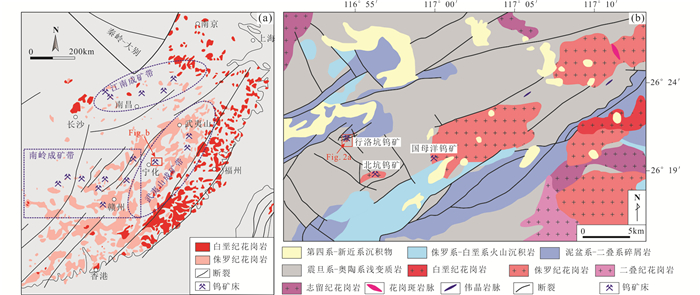
|
图 1 武夷山成矿带区域构造位置图(a)及行洛坑钨矿区域地质简图(b)(据孙涛, 2006; 瞿承燚, 2016修改) Fig. 1 Regional tectonic outline of the Wuyishan metallogenic belt (a) and regional geological map of the Xingluokeng deposit (modified after Sun, 2006; Qu, 2016) |
行洛坑钨矿位于武夷山成矿带中段(图 1a)。新元古代-奥陶系浅变质岩在区域上广泛分布,上覆泥盆系-奥陶系碎屑岩及侏罗系-白垩系火山-沉积岩。区内发育志留纪、二叠纪、侏罗纪及白垩纪多期次花岗岩类。一系列区域性NE、NEE向断裂、次级的NW向断裂构造控制着中生代花岗岩类的展布(图 1b)。
2 矿床地质特征行洛坑钨矿位于福建省西部宁化县东北约35km处。矿区出露地层主要为震旦系三溪寨组及中泥盆系天瓦岽组(图 2a)。三溪寨组从下到上分为三个岩性层,包括变质粉砂岩夹碳酸盐岩透镜体(第一岩性层),变质长石-石英砂岩(第二岩性层)及互层的变质细砂岩和粉砂岩(第三岩性层)。NEE向的行洛坑倒转背斜(轴面倾向SE,倾角43°~62°)控制着主要地层单元的分布,第一岩性层分布于背斜核部,第二岩性层分布于背斜两翼。天瓦岽组主要由砾岩和砂岩构成,出露于矿区西北侧,不整合覆盖于三溪寨组之上。矿区断裂构造以NEE向为主,其次为NW向,其中NEE向断裂控制着行洛坑花岗岩岩株的产出,同时也是石英大脉型矿体的主要控矿构造(图 2a)。
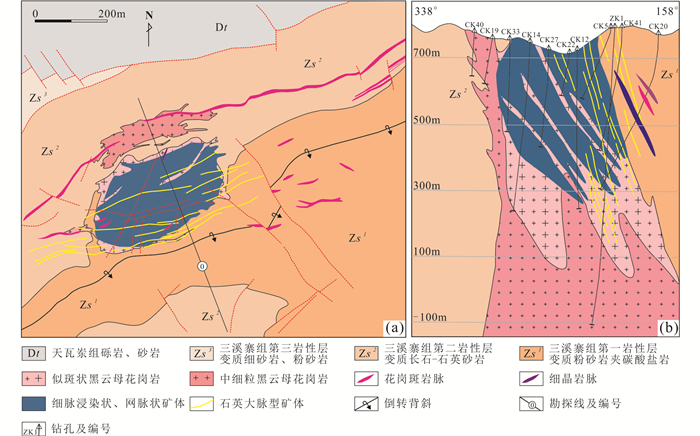
|
图 2 行洛坑钨矿地质简图(a)及0勘探线剖面图(b)(据福建闽西地质大队, 1985修改) Fig. 2 The simplified geological map (a) and geological section along No.0 exploration line (b) of the Xingluokeng tungsten (modified after The Western Geological Party of Fujian, 1985) |
行洛坑成矿相关花岗岩沿三溪寨组第一岩性层、第二岩性层的界面侵入,呈小岩株状产出,地表出露面积0.128km2。岩株在剖面上呈桶状,上部岩性为似斑状黑云母花岗岩,下部被中细粒黑云母花岗岩侵入(图 2b)。似斑状黑云母花岗岩以含不均匀分布的钾长石巨斑晶(1~4cm)为主要特征,在岩体上部钾长石斑晶最高达30%,向下部逐渐减少;中细粒黑云母花岗岩具有中细粒结构(矿物粒径1~4mm),含钾长石(35%~40%)、斜长石(25%~30%)、石英(30%~35%)和黑云母(5%~10%)。锆石U-Pb定年显示两类花岗岩具有相近的成岩年龄,分别为152.5±1.4Ma和152.2±1.2Ma(Wang et al., 2021)。矿区内似斑状黑云母花岗岩普遍遭受不同程度的蚀变,而中细粒花岗岩相对新鲜。此外,在岩体与三溪寨组第一岩性层的接触带,可见一定量的围岩捕掳体,呈棱角状产出。矿区见有穿插于岩体中晚期岩脉,包括细晶岩脉、花岗斑岩脉及辉绿岩脉等。围绕岩株形成了热接触变质带,从接触带向外大致分为红柱石黑云母角岩带(宽20~70m)和黑云母长英质角岩带(宽250~300m)。
行洛坑矿区钨矿化主要赋存于岩株的上部的似斑状黑云母花岗岩内(图 2b),具有明显的“全岩矿化”和“低品位大吨位”特征。矿体在地表延伸达490m,最大厚度336m,平均厚度297m,已探明WO3金属量30.43万吨,平均品位0.23%,伴生钼金属量3.02万吨,平均品位0.024%(福建闽西地质大队, 1985)。主矿体由细脉浸染状(脉宽 < 2cm)、网脉状(脉宽2~10cm)矿化构成,含白钨矿与黑钨矿的含量约1:1。此外,矿区总计产出19条石英大脉型矿体(脉宽>10cm,多数在17~57cm之间),呈NEE向展布,倾向SE,延伸71~447m。大脉型矿体主要产于岩体的南部,并延伸进入围岩50~80m范围内。石英细脉和大脉中黑钨矿U-Pb定年显示其形成年龄分别为151.3±5.8Ma和150.5±8.1Ma(张清清等, 2020),与细脉浸染状矿石中辉钼矿Re-Os加权平均年龄(151.48±0.98Ma, 张家菁等, 2008)在误差范围内基本一致,代表了矿床成矿时代。此外,靠近花岗岩岩株与三溪寨组第一岩性层的外接触带的钙质粉砂岩或白云质灰岩小夹层内,可见少量透镜状产出的透辉石矽卡岩,其中发育浸染状的白钨矿。
矿区整个岩株顶部均发育不同程度的蚀变,蚀变类型主要为钾化、云英岩化,其次为绢云母化、硅化、绿泥石化、萤石化、矽卡岩化、碳酸盐化等。成矿早期阶段钾化具有面型蚀变特征,在岩体顶部较发育,以钾长石化为主,局部可见黑云母化及磁铁矿化(图 3a),此外在含矿石英脉中也发育明显的钾长石化(图 3c, d);云英岩化及绢云母化普遍较发育,叠加在早期钾长石化之上。按矿物组合和矿物穿插、交代关系,划分为三个成矿阶段,各个成矿阶段主要特征概述如下。
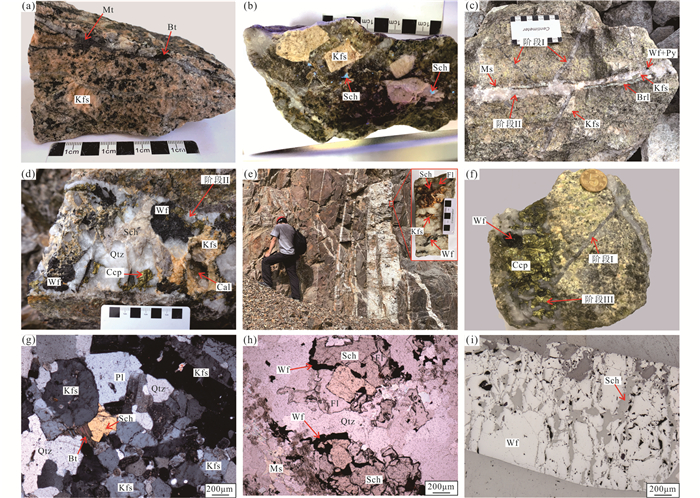
|
图 3 行洛坑钨矿矿化与蚀变特征照片 (a)钾化似斑状黑云母花岗岩;(b)似斑状黑云母花岗岩中浸染状白钨矿(荧光);(c)钾长石-绿柱石-黑钨矿-石英脉(阶段Ⅱ)穿切白钨矿、辉钼矿细脉(阶段Ⅰ);(d)钾长石-黑钨矿-白钨矿-石英脉(阶段Ⅱ);(e)石英大脉型矿体,含黑钨矿、钾长石和少量白钨矿;(f)黄铜矿-黄铁矿-黑钨矿-石英脉(阶段Ⅲ)穿切白钨矿、辉钼矿细脉(阶段Ⅰ);(g)中细粒黑云母花岗岩中浸染状白钨矿(正交偏光);(h)自形白钨矿、萤石被黑钨矿交代(单偏光);(i)板状黑钨矿被白钨矿交代(单偏光和反射光).Brl-绿柱石;Bt-黑云母;Cal-方解石;Ccp-黄铜矿;Kfs-钾长石;Fl-萤石;Qtz-石英;Sch-白钨矿;Ms-白云母;Mt-磁铁矿;Wf-黑钨矿 Fig. 3 Photographs showing mineralization and alteration features of the Xingluokeng tungsten deposit (a) potassium alteration in porphyritic biotite granite; (b) veinlet-disseminated scheelite occurring in the porphyritic biotite granite (under the fluorescent lamp); (c) K-feldspar-beryl-wolframite-quartz vein (stage Ⅱ) crosscutting the scheelite-molybdenite veinlets (stage Ⅰ); (d) K-feldspar-scheelite-wolframite-quartz vein (stage Ⅱ); (e) large quartz vein-type ore body, containing wolframite, K-feldspar and minor scheelite; (f) chalcopyrite-pyrite-wolframite-quartz vein (stage Ⅲ) crosscutting scheelite-molybdenite veinlets (stage Ⅰ); (g) disseminated scheelite occurring in medium- to fine-grained biotite granite (cross-polarized light); (h) euhedral scheelite and fluorite replaced by wolframite (plane-polarized light); (i) tabular wolframite replaced by scheelite (plane-polarized light and reflected light). Brl-beryl; Bt-biotite; Cal-calcite; Ccp-chalcopyrite; Kfs-K-feldspar; Fl-fluorite; Qtz-Quartz; Sch-scheelite; Ms-muscovite; Mt-magnetite; Wf-wolframite |
阶段Ⅰ:细脉浸染状白钨矿-辉钼矿阶段,以发育密集的浸染状白钨矿与含白钨矿、辉钼矿石英微脉、细脉为特征(图 3b, c)。浸染状白钨矿见于未见明显蚀变的黑云母花岗岩内(图 3g),含量随蚀变程度的增强而增多。该阶段石英(微)细脉宽度多数 < 2cm,呈铅灰色,辉钼矿多呈细鳞片状分布于石英脉边部,白钨矿紫外光下发黄色-蓝白色荧光。
阶段Ⅱ:钾长石-白钨矿-黑钨矿-绿柱石阶段:该阶段形成的含矿石英脉明显切穿早阶段矿化(图 3c),含矿石英脉呈脉状、网脉状或大脉状产出(图 3d, e),矿石矿物为白钨矿、黑钨矿,少量的硫化物、锡石,脉中钾长石含量较高,局部出现绿柱石、萤石等(图 3c, d)。该阶段中白钨矿明显被黑钨矿交代(图 3h),脉侧发育强烈的云英岩化和绢云母化。
阶段Ⅲ:硫化物-黑钨矿-白钨矿-碳酸盐阶段:该阶段石英脉呈脉状、网脉状或大脉状产出,脉中出现大量黄铜矿、闪锌矿、黄铁矿等硫化物(图 3f);钾长石含量减少,发育晶洞,出现铁白云石等碳酸岩类矿物。此阶段脉中黑钨矿被白钨矿交代(图 3i),白钨矿紫外光下发蓝色荧光,脉侧蚀变以云英岩化为主,产于浅变质岩中的石英脉见白云母镶边。
3 采样和实验测试方法用于原位LA-ICP-MS微量元素、Sr同位素、流体包裹体显微测温和H-O同位素分析的不同成矿阶段的白钨矿和石英样品采集自行洛坑矿区露天采坑的660~760m中段,详细的采样位置及样品特征列于表 1。
|
|
表 1 行洛坑钨矿代表性样品特征和采样位置 Table 1 Characteristics and locations of representative samples of the Xingluokeng tungsten deposit |
白钨矿CL图像拍摄和LA-ICP-MS原位微量元素分析在武汉上谱分析科技有限责任公司完成。CL图像拍摄所用仪器为高真空扫描电子显微镜(JSM-IT100),配备有GATANmINICL系统。LA-ICP-MS原位微量元素分析所用仪器为相干193nm准分子激光剥蚀系统(GeoLas HD),ICP-MS型号为Agilent 7900。激光剥蚀过程中采用氦气作载气、氩气为补偿气以调节灵敏度,二者在进入ICP之前通过一个T型接头混合,激光剥蚀系统配置有信号平滑装置。本次分析的激光能量为80mJ,束斑和频率分别为44μm和5Hz。白钨矿微量元素含量处理采用USGS玻璃标准物质NIST 610、BHVO-2G、BCR-2G和BIR-1G进行多外标无内标校正(Liu et al., 2008),参考物质元素含量推荐值引自GeoRem (http://georem.mpch-mainz.gwdg.de/)。每个时间分辨分析数据包括大约20~30s空白信号和50s样品信号。对分析数据的离线处理(包括对样品和空白信号的选择、仪器灵敏度漂移校正以及元素含量计算)采用软件ICPMSDataCal 10.8(Liu et al., 2008)完成。
白钨矿原位Sr同位素分析在国家地质实验测试中心完成,所用仪器为ASIJ-200343nm飞秒激光(Applied Spectra公司,美国)和Neptune Plus多接收电感耦合等离子体质谱仪(MC-ICP-MS,Thermo Fisher公司,德国)。采用线扫描方式剥蚀样品,束斑直径20μm,线长40μm,线扫描速度0.65μm/s,激光频率为8~10Hz,能量密度约10J/cm2。每个分析点采集20s空白信号和32s的样品信号,每分析10个样品点测定1次实验室内部白钨矿标样XJSW(Li et al., 2018b)。通过背景扣除校正Kr同位素对84Sr和86Sr的干扰,通过半质量数方法扣除Er的Yb二次离子的干扰。13个XJSW白钨矿标样获得87Sr/86Sr平均值为0.720843±0.000044(2σ),与TIMS方法获得的XJSW 87Sr/86Sr比值0.720858±0.000009相近(Li et al., 2018b)。
石英、白钨矿流体包裹体测温工作在中国地质科学院矿产资源研究所流体包裹体实验室完成,显微测温所用仪器型号分别为Linkam THMSG 600型显微冷热台,温度范围-196~+600℃,≤30℃是测试精度为±0.1℃,>30℃时测试精度为±1℃。含CO2三相包裹体、气液两相包裹体盐度的计算分别采用Collins (1979)和Bodnar (1993)的公式完成。
石英和白钨矿的H-O同位素分析在核工业北京地质研究院测试研究中心完成。氧同位素组成测定采用BrF5法,将样品中的氧转化为O2,然后在700℃与石墨反应生成CO2,采用Delta v advantage型气体同位素质谱仪分析获得δO值,测试精度±0.2‰;氢同位素组成测定采用爆裂法获取水,然后锌法制氢,采用MAT-253型气体同位素质谱仪分析获得δH值,测试精度±2‰。上述测量结果以V-SMOW为标准。
4 实验分析结果 4.1 白钨矿结构特征行洛坑钨矿白钨矿经历了多阶段的溶解、再沉淀过程,表现出复杂的内部结构。根据阴极发光特征及矿物组合,本次研究在阶段Ⅰ-Ⅲ共识别出8个世代的白钨矿。阶段Ⅰ中白钨矿SchⅠ-1呈星点状散布于无明显蚀变的中细粒黑云母花岗岩内,与黑云母、斜长石、锆石等造岩矿物共生(图 4a),粒径0.1~0.3mm,呈半自形粒状,CL图像上颜色较深,显示细密的、均匀的震荡环带(图 4b)。此类白钨矿含量较少,而随着蚀变程度的加强,细脉浸染状白钨矿、辉钼矿含量明显增加;SchⅠ-2多为半自形-他形粒状,粒径0.2~2mm,与SchⅠ-1类似发育细密的震荡环带,CL阴极发光上呈灰黑色,沿边部和裂隙被CL发光强度更高的SchⅠ-3白钨矿所交代(图 4c)。阶段Ⅱ白钨矿呈粒状或集合体状产出,粒径0.5~3cm,CL图像上显示出核边结构,核部(SchⅡ-1)发光强度最弱,呈现明显的交代残余结构,幔部(SchⅡ-2)呈灰色,发育弱的生长环带,边部(SchⅡ-3)呈灰白色,交代早期白钨矿(图 4d)。阶段Ⅲ白钨矿呈他形不规则状,按CL发光强度强弱分为SchⅢ-1和SchⅢ-2,均不发育或仅发育较弱的生长环带(图 4e)。

|
图 4 行洛坑钨矿白钨矿阴极发光特征图像 (a)浸染状白钨矿产于黑云母中,与锆石共生(BSE图像);(b、c)阶段Ⅰ白钨矿CL图像;(d、e)阶段Ⅱ和阶段Ⅲ白钨矿CL图像.Zrn-锆石 Fig. 4 Cathodoluminescence images of scheelites from the Xingluokeng tungsten deposit (a) BSE images showing disseminated scheelite occurring in biotite crystal, associated with zircon; (b, c) CL images showing scheelites from stage Ⅰ; (d, e) CL images showing scheelites from stage Ⅱ and Ⅲ, respectively. Zrn-zircon |
各成矿阶段代表性白钨矿LA-ICP-MS微量元素含量列于表 2。从阶段Ⅰ至阶段Ⅲ,白钨矿球粒陨石标准化分布型式和稀土元素含量呈现规律性的变化(图 5)。阶段Ⅰ中SchⅠ-1白钨矿具有最高的稀土元素含量(∑REE=4355×10-6~6008×10-6),呈现MREE富集型(除Eu外)的稀土元素分布型式,具有强烈的负Eu异常(δEu=0.03~0.05);SchⅠ-2与SchⅠ-1白钨矿稀土元素分布型式相近,但MREE富集程度减小;SchⅠ-3白钨矿稀土总量明显降低(∑REE=589×10-6~1293×10-6),δEu明显增大(0.13~0.76)。阶段Ⅱ白钨矿总体具有平坦的稀土元素球粒陨石标准化分布型式,从SchⅡ-1到SchⅡ-3稀土总量逐渐降低(∑REE=133×10-6~2642×10-6),除2-12点外,均表现出中等至弱的负Eu异常(δEu=0.27~0.97)。阶段Ⅲ白钨矿稀土元素总量最低(∑REE=46×10-6~737×10-6),出现弱至强烈的正Eu异常(δEu=1.03~8.93)。
|
|
表 2 行洛坑钨矿白钨矿原位LA-ICP-MS微量元素组成(×10-6) Table 2 In-situ trace element data for scheelite from the Xingluokeng tungsten deposit (× 10-6) |
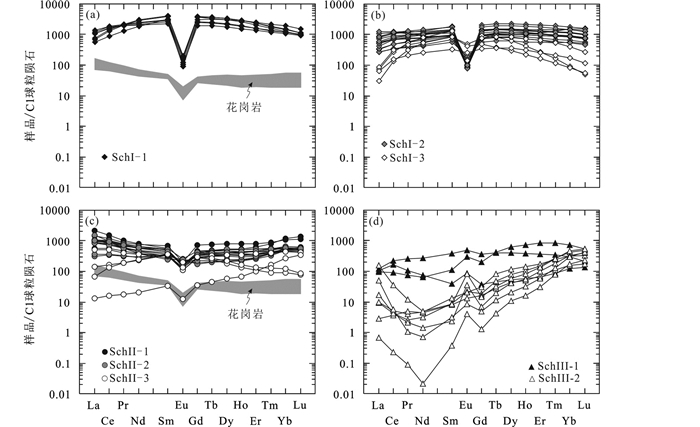
|
图 5 行洛坑钨矿白钨矿球粒陨石标准化稀土元素配分模式图(球粒陨石标准化值据Sun and McDonough, 1989) 花岗岩稀土元素组成据Wang et al., 2021 Fig. 5 Chondrite-normalized REE patterns of scheelites from the Xingluokeng tungsten deposit (normalization values after Sun and McDonough, 1989) The REE compositions of granites from Wang et al., 2021 |
除稀土元素外,行洛坑钨矿不同成矿阶段的白钨矿Mo、Sr、Na、Nb等元素的含量也具有明显的变化,阶段Ⅰ白钨矿富Mo、贫Sr(图 6a,b),而阶段Ⅱ和Ⅲ白钨矿Mo含量逐渐降低,Sr含量显著升高(图 6a, b)。阶段Ⅰ白钨矿(SchⅠ-1和SchⅠ-2)具有较高Na含量(180×10-6~895×10-6)和Nb含量(608×10-6~3318×10-6),而随着流体演化,白钨矿中的Na和Nb含量明显降低,阶段Ⅲ白钨矿中Na和Nb含量最高仅为37.7×10-6和89.1×10-6(图 7)。

|
图 6 行洛坑钨矿白钨矿Mo(a)、Sr(b)含量与∑REE协变关系图 Fig. 6 The Mo (a) and Sr (b) versus ∑REE diagrams of scheelites from the Xingluokeng tungsten deposit |

|
图 7 行洛坑钨矿白钨矿Na(a)和Nb (b)含量与∑REE+Y-Eu协变关系图 Fig. 7 The Na (a) and Nb (b) versus ∑REE+Y-Eu diagrams of scheelites from the Xingluokeng tungsten deposit |
行洛坑白钨矿原位Sr同位素数据列于表 3。阶段Ⅰ至Ⅲ白钨矿87Rb/86Sr比值介于0.0001~0.8741,87Sr/86Sr比值介于0.7135~0.7383,阶段Ⅰ中部分白钨矿(SchⅠ-1和SchⅠ-2) Sr含量相对较低,不确定度相对较高(2σ=0.0011~0.0044),其余分析点的不确定度介于0.0001~0.0012。以行洛坑钨矿的成矿年龄151Ma(张清清等, 2020)计算,获得三个成矿阶段白钨矿(87Sr/86Sr)i比值分别为0.7133~0.7263、0.7212~0.7273和0.7212~0.7383。
|
|
表 3 行洛坑钨矿白钨矿原位Sr同位素组成 Table 3 In-situ Sr isotopic compositions of scheelites from the Xingluokeng tungsten deposit |
本次对行洛坑钨矿各成矿阶段的石英和白钨矿中的流体包裹体进行了岩相学观察和显微测温研究。根据流体包裹体室温下相态及冷冻回温过程中相态的变化,可以将原生流体包裹体划分为含CO2三相包裹体(C型)、富液相包裹体(L型)和富(纯)气相包裹体(V型)三类。C型包裹体多呈孤立状分布,气相体积分数在30%~70%之间,部分C型包裹体在室温下表现为富气两相包裹体,而在冷冻过程中沿CO2气相边部出现CO2液相。L型包裹体呈群簇状或孤立状产出,在各个成矿阶段均广泛分布,气相体积分数多为15%~45%。C型包裹体在阶段Ⅰ和阶段Ⅱ中含量较高(图 8a, b),阶段Ⅱ常见不同充填度的包裹体沿同一生长环带成群产出(图 8c),即共存于同一流体包裹体组合内(Goldstein and Reynolds, 1994);而阶段Ⅲ的白钨矿和石英中以L型包裹体为主,C型包裹体不发育(图 8d, e)。
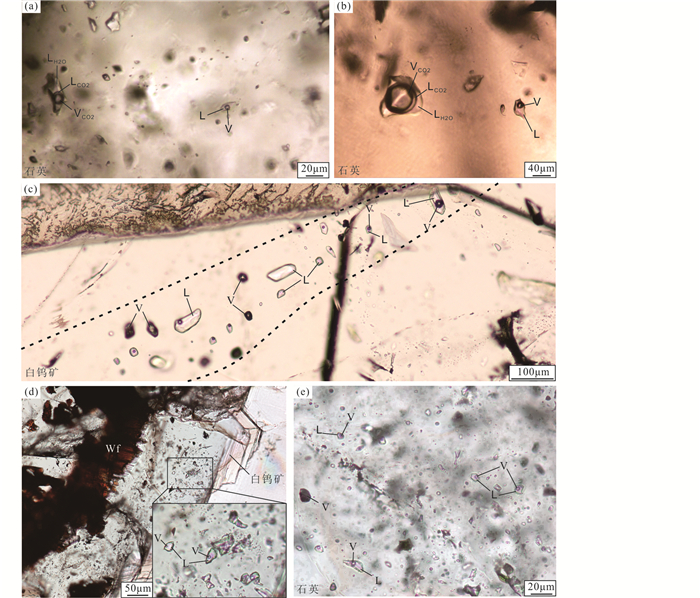
|
图 8 行洛坑钨矿不同类型流体包裹体照片 (a)阶段Ⅰ石英中的C型、L型包裹体;(b)阶段Ⅱ石英中共存的C型、L型包裹体;(c)阶段Ⅱ白钨矿中不同充填度的包裹体产于同一流体包裹体组合内;(d、e)阶段Ⅲ白钨矿、石英中以L型包裹体为主.L-水溶液相;V-气相 Fig. 8 The photomicrographs of different types of fluid inclusions in the Xingluokeng tungsten deposit (a) C-type and L-type fluid inclusions in quartz of stage Ⅰ; (b) C-type and L-type fluid inclusions coexisting in quartz of stage Ⅱ; (c) fluid inclusions with varible filling degrees coexisting in a fluid inclusion assemblage in scheelite of stage Ⅱ; (d, e) L-type fluid inclusions in scheelite and quartz in stage Ⅲ. L-liquid; V-vapor |
本次研究对各阶段代表性的L型和C型包裹体进行了显微测温,测温结果列于表 4。阶段Ⅰ石英中流体包裹体均一温度在221~378℃之间,平均290℃,盐度为2.1%~12.5% NaCleqv,平均7.3% NaCleqv;阶段Ⅱ石英和白钨矿中流体包裹体均一温度在206~364℃之间,平均268℃,盐度为3.4%~12.4% NaCleqv,平均8.0% NaCleqv;阶段Ⅲ石英和白钨矿中流体包裹体均一温度在186~281℃之间,平均234℃,盐度为2.4%~8.4% NaCleqv,平均4.2% NaCleqv。
|
|
表 4 行洛坑钨矿流体包裹体显微测温结果 Table 4 The microthemometric results of fluid inclusions from the Xingluokeng tungsten deposit |
行洛坑钨矿不同成矿阶段石英和白钨矿的H、O同位素数据列于表 5。阶段Ⅰ矿物中H2O的δDV-SMOW值介于-63.5‰~-48‰,矿物δ18OV-SMOW值为3.4‰~14.5‰,计算获得相应的δ18OH2O值为4.0‰~7.2‰;阶段Ⅱ矿物中H2O的δDV-SMOW值介于-71‰~-56‰,矿物δ18OV-SMOW值为11.9‰~12.3‰,计算获得相应的δ18OH2O值为3.8‰~4.2‰;阶段Ⅲ矿物中H2O的δDV-SMOW值介于-65.2‰~-57.8‰,矿物δ18OV-SMOW值为0.9‰~12.1‰,计算获得相应的δ18OH2O值为1.4‰~2.4‰。
|
|
表 5 行洛坑钨矿H-O同位素组成(‰) Table 5 The H-O isotopic compositions of the Xingluokeng tungsten deposit (‰) |
稀土元素(REE3+)以类质同象形式置换Ca2+进入白钨矿晶格需要保持电价的平衡,主要有三种置换方式(Nassau and Loiacono, 1963; Burt, 1989; Brugger et al., 2000):① 2Ca2+=REE3++Na+;② Ca2++W6+=REE3++Nb5+;③ 3Ca2+=2REE3++□Ca,其中□Ca代表Ca的空位。不同的稀土元素置换机制会直接影响白钨矿中稀土元素的分布型式。其中,以Na+REE(方式①)为主的置换形成的白钨矿中具有较高的Na含量,且由于MREE3+与Ca2+的离子半径更接近(MREE3+: 1.06Å, Ca2+: 1.12Å, Shannon, 1976),MREE将优先进入白钨矿晶格,因此,稀土元素在球粒陨石标准化分布图中呈“驼峰”状分布(Ghaderi et al., 1999)。以Nb+REE(方式②)为主的置换型式形成的白钨矿具有较高的Nb含量,HREE或MREE相对于LREE可能更优先进入白钨矿晶格(Li et al., 2021)。此外,由于Nb5+(0.46Å)与Mo5+(0.41Å)离子半径更接近,相对还原条件下Nb也可能与Mo共同置换W而进入白钨矿(Zhao et al., 2018)。上述两种置换机制形成白钨矿,Na或Nb与稀土总量将具有近似1:1的正相关关系,稀土元素分布型式将主要受白钨矿晶体结构的控制。而与□Ca结合的REE3+(方式③)进入白钨矿晶格的REE将不受到离子半径大小的限制,REE3+进入白钨矿晶格没有选择性,此时白钨矿稀土元素分布型式主要取决于成矿流体的稀土元素组成(Ghaderi et al., 1999)。
行洛坑钨矿阶段Ⅰ白钨矿(SchⅠ-1和SchⅠ-2)具有较高的Na含量(180×10-6~895×10-6,平均456×10-6)和Nb含量(608×10-6~3318×10-6,平均1762×10-6)。在∑REE+Y-Eu与Na和Nb含量协变图中均表现出明显的正相关关系,但略高于1:1演化线(图 7a, b),表明SchⅠ-1和SchⅠ-2中可能同时存在Na和Nb对REE的类质同象置换。在球粒陨石标准化稀土元素分布型式图中,白钨矿SchⅠ-1具有中稀土富集型的“驼峰”状分布型式,与成矿相关黑云母花岗岩稀土元素组成有明显差异(图 5a),表明SchⅠ-1白钨矿中REE更可能是受晶体结构控制为主,Na和Nb+REE的置换方式是该阶段REE进入白钨矿晶格的主要方式。而随着流体的演化,早期富MREE白钨矿的大量分离结晶将导致残余流体中MREE的逐渐亏损,因此SchⅠ-2白钨矿中MREE富集趋势逐渐减小(图 5b)。
相比于阶段Ⅰ,阶段Ⅱ与阶段Ⅲ白钨矿中Na和Nb含量明显降低(图 7a, b),在REE+Y-Eu与Na和Nb含量协变图中相关关系不明显(图 7a, b),表明此时白钨矿中稀土元素REE3+是与□Ca结合的方式为主进入白钨矿晶格。因此,阶段Ⅱ与阶段Ⅲ白钨矿可以反映成矿流体的稀土元素组成和特点。白钨矿SchⅡ-1、SchⅡ-2具有平坦的稀土元素球粒陨石标准化分布型式和中等的负Eu异常,与成矿相关黑云母花岗岩的稀土分布型式更为接近(图 5c),进一步证明了该阶段白钨矿稀土元素特征主要继承自早期成矿流体。从阶段Ⅱ到阶段Ⅲ白钨矿稀土元素含量逐渐降低,与白钨矿的连续分离结晶导致的流体成分变化有关。
Eu作为变价元素,可以通过Eu3+或Eu2+的形式置换白钨矿中的Ca。Eu3+的地球化学行为与其他稀土元素(REE3+)类似,因此Eu以Eu3+的形式进入白钨矿晶格,EuN与EuN*(EuN*=(SmN×GdN)1/2)将具有明显的正相关关系;当Eu以Eu2+形式出现时,Eu2+置换白钨矿中的Ca2+不受电价平衡的控制,其置换行为与Sm3+和Gd3+元素不一致,所以EuN与EuN*无明显相关性(Raimbault et al., 1993; Ghaderi et al., 1999)。行洛坑钨矿阶段Ⅰ和阶段Ⅱ白钨矿均具有高的EuN*值,EuN与EuN*不存在明显的正相关关系,表明此时成矿流体中Eu以Eu2+为主;阶段Ⅲ中白钨矿EuN与EuN*表现出弱的正相关关系,说明此阶段Eu3+含量相对增多(图 9)。

|
图 9 行洛坑钨矿白钨矿EuN与EuN*协变关系图 Fig. 9 The EuN vs. EuN* diagram of scheelites from the Xingluokeng tungsten deposit |
白钨矿中的Eu异常可以继承自初始成矿流体,也可能与白钨矿连续沉淀、水岩反应导致的流体组成和流体性质(如pH值)的变化有关(Ghaderi et al., 1999; Brugger et al., 2000, 2008; Li et al., 2018a; Chen et al., 2020; Li et al., 2021)。行洛坑钨矿阶段Ⅰ白钨矿强烈的负Eu异常一方面继承自成矿流体,另一方面由于Eu2+在流体和白钨矿之间的分配系数明显低于REE3+(Brugger et al., 2000),而大量的REE3+通过与Na和Nb结合进入白钨矿晶格,导致了白钨矿SchⅠ-1中强烈的负Eu异常(图 5a)。阶段Ⅱ与阶段Ⅲ白钨矿中REE3+与□Ca结合进入白钨矿晶格,Eu异常主要受流体稀土元素组成的控制。阶段Ⅱ白钨矿形成过程中经历了CO2流体不混溶作用,大量CO2的逃逸将引起流体pH值的升高,而该阶段白钨矿具有较一致的中等的负Eu异常,表明pH值的变化并不是影响该阶段白钨矿Eu异常的主要因素。随着流体演化,阶段Ⅲ白钨矿的δEu值逐渐升高,这种连续变化与白钨矿的大量分离结晶导致流体组分的变化有关,同时也受到持续的水岩反应导致外部Eu的加入的影响。
5.2 成矿流体来源及演化过程行洛坑钨矿阶段Ⅱ白钨矿与成矿相关花岗岩一致的球粒陨石标准化稀土元素分布型式(图 5c),表明成矿流体主要为源自岩浆流体的出溶。元素Y和Ho具有相似的离子半径和离子电荷(Bau and Dulski, 1995),因此Y/Ho比值在同一热液体系演化过程中保持稳定,而经历了流体混合或水岩反应改造后的流体Y/Ho比值可能发生明显的变化。行洛坑钨矿阶段Ⅰ和阶段Ⅱ白钨矿Y和Ho含量具有明显的相关性,而阶段Ⅲ白钨矿Y和Ho之间的相关性变弱(图 10),指示成矿晚期阶段可能有外部流体的加入,导致成矿体系组成或性质的改变。H-O同位素为成矿流体的来源提供了进一步的证据。行洛坑钨矿阶段Ⅰ和Ⅱ成矿流体H-O均投于靠近岩浆水的范围,而阶段Ⅲ成矿流体投点略向大气降水线偏移(图 11a),进一步证明了行洛坑钨矿成矿流体以岩浆流体为主,而晚期阶段有少量的大气降水混入。
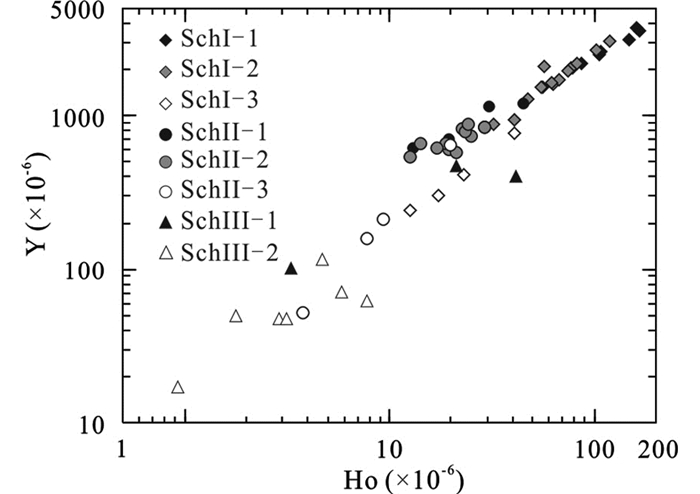
|
图 10 行洛坑钨矿白钨矿Y与Ho协变关系图 Fig. 10 The Y vs. Ho diagram of scheelites from the Xingluokeng tungsten deposit |
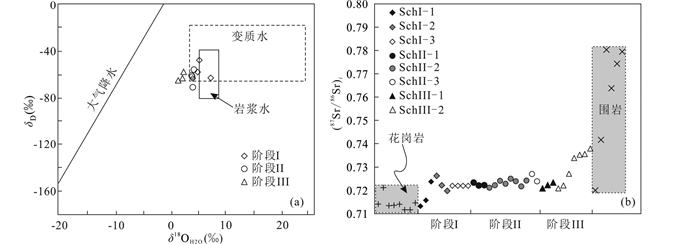
|
图 11 行洛坑钨矿H-O(a, 底图据Taylor, 1979)及Sr同位素(b)组成 花岗岩与围岩Sr同位素数据来自蔡元来, 1984; 朱玉磷和葛如庚, 1986; Wang et al., 2021 Fig. 11 H vs. O (a, base map after Taylor, 1979) and Sr (b) isotopic compositions of the Xingluokeng tungsten deposit The Sr isotopic data of granites and wall rocks are from Cai, 1984; Zhu and Ge, 1986; Wang et al., 2021 |
前已述及,行洛坑钨矿阶段Ⅰ和阶段Ⅱ均以Eu2+为主,而阶段Ⅲ成矿流体中Eu3+的含量升高,表明早期成矿流体氧逸度较低,而晚期阶段氧逸度有一定程度的升高。行洛坑钨矿成矿相关花岗岩具有较低的全岩Fe2O3/FeO比值(平均0.21)及锆石Ce4+/Ce3+比值(平均44~104)(Wang et al., 2021),属于还原性的钛铁矿系列花岗岩,因此成矿早阶段流体还原性特征应源于还原性的成矿母岩。晚期成矿阶段氧化性的大气降水的加入可能是引起成矿流体中Eu3+含量升高的主要原因。行洛坑白钨矿中的Sr同位素组成相对均一,多数(87Sr/86Sr)i比值集中在0.7133~0.7273之间,与成矿相关黑云母花岗岩的Sr同位素组成相近(图 11b),而仅在成矿阶段晚期(SchⅢ-2),(87Sr/86Sr)i比值明显升高,最高达到0.7383,这可能与成矿晚期阶段大气降水带入部分围岩来源的Ca有关。综上,行洛坑钨矿成矿流体以还原性岩浆流体为主,随着成矿晚期阶段少量的大气降水加入,成矿流体氧逸度略有升高。
5.3 钨的沉淀富集机制已有研究证实,钨在热液流体中主要以WO42-的形式与Na+、K+或H+结合形成络合物进行迁移(Heinrich, 1990; Wood and Samson, 2000; Wang et al., 2020)。溶液中离子活度,如α(Ca2+)、α(Fe2+)和α(Mn2+)等,及成矿环境物理化学条件(温度、压力、pH值,氧逸度等)的变化都可能导致钨的沉淀。目前认为引起钨沉淀的主要因素包括:温度降低(Ni et al., 2015; Chen et al., 2018)、流体混合(Wei et al., 2012; Legros et al., 2019; Pan et al., 2019)、水岩反应(Lecumberri-Sanchez et al., 2017)及流体不混溶作用(Korges et al., 2018)等。
行洛坑钨矿成矿阶段Ⅰ与阶段Ⅱ白钨矿大量的沉淀,流体包裹体显微测温获得平均温度分别为290℃和268℃(表 4),成矿温度并未明显降低,且仅成矿晚期阶段经历了有限的流体混合作用(图 11),表明降温和流体混合并不是行洛坑钨矿白钨矿和黑钨矿沉淀的主要因素。行洛坑钨矿具有“全岩矿化”特征,整个岩株顶部均发育不同程度的弥散状蚀变;随着成矿流体的演化,白钨矿中Sr的含量持续升高(图 6b);阶段Ⅱ至阶段Ⅲ白钨矿中Eu由中等的负异常转变为明显的正异常,均指示了持续的水岩反应过程。赋矿花岗岩岩株由下部的中等至高分异的中细粒黑云母花岗岩(SiO2含量为73.06%~76.13%)和上部弱分异似斑状黑云母花岗岩构成(SiO2含量为68.52%~73.39%),似斑状黑云母花岗岩中斜长石的CaO含量达到10.78%(Wang et al., 2021)。强烈的水岩相互作用导致斜长石分解提供了白钨矿结晶所需的Ca,并可能为黑钨矿的结晶提供了部分的Fe和Mn,这也是细脉浸染型、网脉型白钨矿主要集中于蚀变岩体内部,而石英大脉型矿体延伸进入围岩一定范围的原因。
此外,流体包裹体的研究证实,行洛坑钨矿成矿早阶段发育大量含CO2流体包裹体,而晚阶段含CO2包裹体数量明显减少。阶段Ⅱ石英内常见不同充填度的包裹体共存于同一流体包裹体组合内(图 8c),表明该阶段发生了广泛的CO2流体不混溶作用。CO2是流体中重要的酸碱平衡缓冲剂,围岩蚀变过程中,CO2发挥“H+储库”效应,有效缓冲流体pH,提高从围岩萃取Ca、Fe、Mn的效率(Wang et al., 2020);而大量CO2随着流体不混溶而逃逸,将引起流体pH值升高,打破钨络合物的迁移平衡(Korges et al., 2018),进而发生富集沉淀。综上,水岩反应和流体不混溶作用是行洛坑钨矿形成的两个关键因素。
矿物生长环带记录了矿物-流体之间相互作用过程,其形成与热液体系环境(组成、压力、温度、氧逸度等)变化密切相关,同时也受到元素扩散和矿物生长速率的影响(Jamtveit and Hervig, 1994; Shore and Fowler, 1996)。行洛坑钨矿发育阶段Ⅰ与阶段Ⅱ、Ⅲ两种不同产状白钨矿,可能指示其形成与不同的热液流体环境中。阶段Ⅰ白钨矿呈浸染状、微脉及细脉状产出,脉侧总体蚀变较弱,此阶段白钨矿由初始岩浆流体沿微小的裂隙迁移渗透,并发生交代而形成。产生的白钨矿多呈自形-半自形粒状产出,发育细密、规则的生长环带,指示其形成于低水岩比环境中,白钨矿结晶相对缓慢,此时REE与Na和Nb结合置换白钨矿中的Ca,其组成主要受晶体结构所控制(Ghaderi et al., 1999)。而阶段Ⅱ和阶段Ⅲ呈脉状、大脉状矿化产出,脉侧蚀变强烈,此阶段白钨矿形成于高水岩比环境中,围岩中裂隙更加发育,压力的迅速降低伴随着CO2的大量逃逸,导致该阶段白钨矿和黑钨矿大量沉淀。此阶段白钨矿多为半自形-他形,不发育或仅发育宽缓的、不规则生长环带,白钨矿稀土元素以3Ca2+=2REE3++□Ca形式进入白钨矿晶格,REE元素反应了成矿流体的稀土元素组成(Ghaderi et al., 1999)。
5.4 矿床成因及对斑岩型钨矿形成的指示行洛坑钨矿自1957年发现以来,前人从不同角度对其成因类型开展了相关的研究工作,主要认识包括花岗岩细脉-网脉型钨矿(蔡元来, 1984)、斑岩型钨矿(张家菁等, 2008; Zhao et al., 2017)、石英脉型钨矿(张清清等, 2020)等。不同类型钨矿轻-中-重稀土元素的相对含量存在较大的差别,因此可以用来指示矿床的成因类型(Song et al., 2014)。在LREE-MREE-HREE图解中,行洛坑钨矿阶段Ⅱ白钨矿投在靠近矽卡岩-斑岩钨-钼矿床的区域,而阶段Ⅲ稀土元素组成与脉型钨矿更为接近,阶段Ⅰ白钨矿主要投在斑岩钨-钼矿和脉型钨矿中间区域(图 12),这也在一定程度上体现了该矿床成矿过程的独特性与复杂性。基于行洛坑钨矿体主要产于强烈蚀变的似斑状黑云母花岗岩内,由密集分布的细脉浸染状、网脉状及大脉状矿化构成,具有“低品位大吨位”与“全岩矿化”特征,我们认为行洛坑钨矿属于广义的斑岩型钨矿。富钨的初始成矿流体主要源自岩株下部中高分异程度的中细粒黑云母花岗岩,流体不断向岩株顶部的似斑状黑云母花岗岩内聚集和循环,产生了广泛的水岩反应与流体不混溶作用,进而发生钨的富集沉淀;早阶段细脉浸染状矿化构成了行洛坑钨矿成矿的基础,而晚阶段网脉状、大脉状矿化的叠加是钨进一步富集关键。
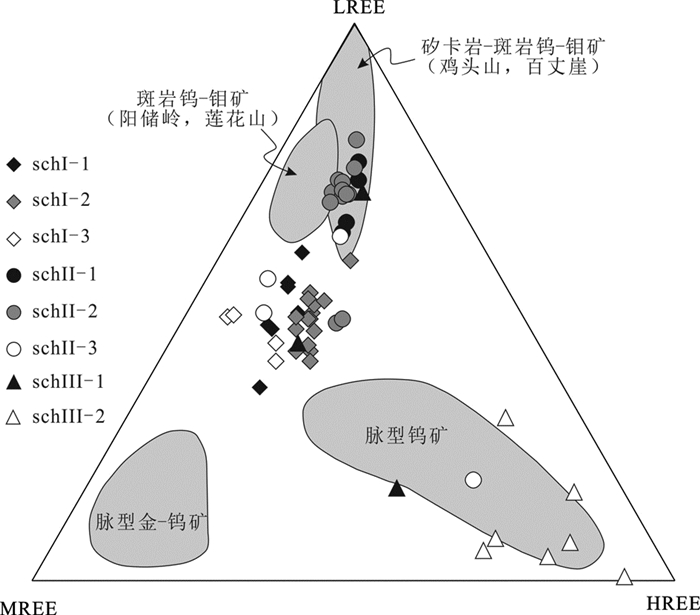
|
图 12 行洛坑钨矿白钨矿LREE-MREE-HREE图解(底图据Song et al., 2014) Fig. 12 LREE-MREE-HREE diagram of scheelites from the Xingluokeng tungsten deposit (base map after Song et al., 2014) |
相比于斑岩型铜矿和斑岩型钼矿,在全球范围内对于斑岩型钨矿的研究甚少(毛景文等, 2020)。过去认为典型矿床包括加拿大的Mount Pleasant W(Mo)矿床、我国广东省的莲花山矿床(Liu et al., 2018)和江西省的阳储岭矿床(Mao et al., 2017)等。这些矿床规模普遍较小,一直未引起足够的重视(Seedorff et al., 2005; Sinclair, 2007)。近年来大湖塘、东源等超大型、大型斑岩型钨矿的发现,证明斑岩型钨矿同样是一种重要的矿床类型(毛景文等, 2020)。高精度定年数据显示赣北大湖塘斑岩型钨矿成矿过程持续了近20Ma(Song et al., 2018),皖南东源斑岩型钨矿形成过程中经历了垂向上多旋回网脉的叠加过程(Wu et al., 2019)。结合行洛坑钨矿成矿过程的系统研究,我们认为多阶段矿化的叠加是斑岩型钨矿形成的关键控制因素。
6 结论(1) 行洛坑钨矿从早至晚经历了三个主要成矿阶段:细脉浸染状白钨矿-辉钼矿阶段(阶段Ⅰ),钾长石-白钨矿-黑钨矿-绿柱石阶段(阶段Ⅱ)及硫化物-黑钨矿-白钨矿-碳酸盐阶段(阶段Ⅲ)。H-O与Sr同位素表明成矿流体主要为岩浆流体,仅成矿晚期阶段有少量的大气降水加入。(2)早阶段白钨矿相对富REE、Mo、Na和Nb,贫Sr;而随着流体演化,白钨矿REE、Mo、Na、Nb含量逐渐降低,Sr含量显著升高。阶段Ⅰ细脉浸染状白钨矿形成于低水岩比环境,由初始岩浆流体沿微小裂隙渗透交代而形成;而阶段Ⅱ、Ⅲ网脉状、大脉状矿化中的白钨矿形成于高水岩比环境,CO2的不混溶作用伴随强烈的水岩反应导致了钨的富集沉淀。
(3) 行洛坑钨矿属于广义的斑岩型钨矿,细脉浸染状矿化构成了钨成矿的基础,而网脉状、大脉状矿化的叠加是钨进一步富集的关键。
致谢 本研究相关野外工作得到福建地质调查研究院陈金良工程师的大力帮助;中国地质科学院矿产资源研究所流体包裹体实验室陈伟十老师对流体包裹体测试进行了细心指导;审稿专家对论文提出了许多建设性的意见和建议;在此一并表示诚挚谢意。
Bau M and Dulski P. 1995. Comparative study of yttrium and rare-earth element behaviours in fluorine-rich hydrothermal fluids. Contributions to Mineralogy and Petrology, 119(2-3): 213-223 DOI:10.1007/BF00307282
|
Bodnar RJ. 1993. Revised equation and table for determining the freezing point depression of H2O-NaCl solutions. Geochimica et Cosmochimica Acta, 57(3): 683-684 DOI:10.1016/0016-7037(93)90378-A
|
Brugger J, Lahaye Y, Costa S, Lambert D and Bateman R. 2000. Inhomogeneous distribution of REE in scheelite and dynamics of Archaean hydrothermal systems (Mt. Charlotte and Drysdale gold deposits, Western Australia). Contributions to Mineralogy and Petrology, 139(3): 251-264 DOI:10.1007/s004100000135
|
Brugger J, Etschmann B, Pownceby M, Liu WH, Grundler P and Brewe D. 2008. Oxidation state of europium in scheelite: Tracking fluid-rock interaction in gold deposits. Chemical Geology, 257(1-2): 26-33 DOI:10.1016/j.chemgeo.2008.08.003
|
Burt DM. 1989. Compositional and phase relations among rare earth element minerals. Reviews in Mineralogy and Geochemistry, 21(1): 259-307
|
Cai YL. 1984. A study of the genetic type of Xingluokeng tungsten (molybdenum) deposit, Fujian Province. Mineral Deposits, 3(1): 27-36 (in Chinese with English abstract)
|
Chen LL, Ni P, Li WS, Ding JY, Pan JY, Wang GG and Yang YL. 2018. The link between fluid evolution and vertical zonation at the Maoping tungsten deposit, southern Jiangxi, China: Fluid inclusion and stable isotope evidence. Journal of Geochemical Exploration, 192: 18-32 DOI:10.1016/j.gexplo.2018.01.001
|
Chen RS, Li JW, Cao K, Qu CY and Li YJ. 2013. Zircon U-Pb and molybdenite Re-Os dating of the Shangfang tungsten deposit in northern Fujian Province: Implications for regional mineralization. Earth Science (Journal of China University Geosciences), 38(2): 289-304 (in Chinese with English abstract) DOI:10.3799/dqkx.2013.029
|
Chen RS, Zhu LY, Jiang SY, Ma Y and Hu QH. 2020. Fluid evolution and scheelite precipitation mechanism of the large-scale Shangfang quartz-vein-type tungsten deposit, South China: Constraints from Rare Earth Element (REE) behaviour during fluid/rock interaction. Journal of Earth Science, 31(4): 635-652 DOI:10.1007/s12583-020-1283-0
|
Chen SZ, Huang ZQ, Zhu XT, Chen G and Ma M. 2013. Magmatism and ore-forming background of the main deposits in Taoxi circular structure along the Wuyishan ore belt. Geology in China, 40(5): 1569-1582 (in Chinese with English abstract)
|
Clayton RN, O'Neil JR and Mayeda TK. 1972. Oxygen isotope fractionation in quartz and water. Journal of Geophysical Research, 77: 57-67
|
Collins PLF. 1979. Gas hydrates in CO2-bearing fluid inclusions and the use of freezing data for estimation of salinity. Economic Geology, 74(6): 1435-1444 DOI:10.2113/gsecongeo.74.6.1435
|
Ding JH, Fan JF, Yin JN and Liu YL. 2016. Geological characteristics and mineral resource potential of the Wuyishan Cu-Pb-Zn polymetallic metallogenic belt. Acta Geologica Sinica, 90(7): 1537-1550 (in Chinese with English abstract)
|
Feng CY, Wang H, Xiang XK and Zhang MY. 2018. Late Mesozoic granite-related W-Sn mineralization in the northern Jiangxi region, SE China: A review. Journal of Geochemical Exploration, 195: 31-48 DOI:10.1016/j.gexplo.2018.06.008
|
Ghaderi M, Palin JM, Campbell IH and Sylvester PJ. 1999. Rare earth element systematics in scheelite from hydrothermal gold deposits in the Kalgoorlie-Norseman region, Western Australia. Economic Geology, 94(3): 423-437 DOI:10.2113/gsecongeo.94.3.423
|
Goldstein RH and Reynolds TJ. 1994. Systematics of Fluid Inclusions in Diagenetic Minerals. Tulsa: SEPM
|
Heinrich CA. 1990. The chemistry of hydrothermal tin (-tungsten) ore deposition. Economic Geology, 85(3): 457-481 DOI:10.2113/gsecongeo.85.3.457
|
Hu RZ, Wei WF, Bi XW, Peng JT, Qi YQ, Wu LY and Chen YW. 2012a. Molybdenite Re-Os and muscovite 40Ar/39Ar dating of the Xihuashan tungsten deposit, central Nanling district, South China. Lithos, 150: 111-118 DOI:10.1016/j.lithos.2012.05.015
|
Hu RZ, Bi XW, Jiang GH, Chen HW, Peng JT, Qi YQ, Wu LY and Wei WF. 2012b. Mantle-derived noble gases in ore-forming fluids of the granite-related Yaogangxian tungsten deposit, southeastern China. Mineralium Deposita, 47(6): 623-632 DOI:10.1007/s00126-011-0396-x
|
Huang WR. 1983. Rock mass and petrologic characteristics of granite-controlled tungsten deposit. Geology and Exploration, (12): 1-5 (in Chinese)
|
Jamtveit B and Hervig RL. 1994. Constraints on transport and kinetics in hydrothermal systems from zoned garnet crystals. Science, 263(5146): 505-508 DOI:10.1126/science.263.5146.505
|
Jiang SY, Zhao KD, Jiang H, Su HM, Xiong SF, Xiong YQ, Xu YM, Zhang W and Zhu LY. 2020. Spatiotemporal distribution, geological characteristics and metallogenic mechanism of tungsten and tin deposits in China: An overview. Science Bulletin, 65(33): 3730-3745 (in Chinese)
|
Korges M, Weis P, Lüders V and Laurent O. 2018. Depressurization and boiling of a single magmatic fluid as a mechanism for tin-tungsten deposit formation. Geology, 46(1): 75-78 DOI:10.1130/G39601.1
|
Lecumberri-Sanchez P, Vieira R, Heinrich CA, Pinto F and Wälle M. 2017. Fluid-rock interaction is decisive for the formation of tungsten deposits. Geology, 45(7): 579-582 DOI:10.1130/G38974.1
|
Legros H, Richard A, Tarantola A, Kouzmanov K, Mercadier J, Vennemann T, Marignac C, Cuney M, Wang RC, Charles N, Bailly L and Lespinasse MY. 2019. Multiple fluids involved in granite-related W-Sn deposits from the world-class Jiangxi Province (China). Chemical Geology, 508: 92-115 DOI:10.1016/j.chemgeo.2018.11.021
|
Li C, Zhou LM, Zhao Z, Zhang ZY, Zhao H, Li XW and Qu WJ. 2018b. In-situ Sr isotopic measurement of scheelite using fs-LA-MC-ICPMS. Journal of Asian Earth Sciences, 160: 38-47 DOI:10.1016/j.jseaes.2018.03.025
|
Li W, Xie GQ, Cook NJ, Mao JW, Li C, Ciobanu CL and Zhang ZY. 2021. Tracking dynamic hydrothermal processes: Textures, in-situ Sr-Nd isotopes and trace element analysis of scheelite from the Yangjiashan vein-type W deposit, South China. American Mineralogist DOI:10.2138/am-2021-7677
|
Li XY, Gao JF, Zhang RQ, Lu JJ, Chen WH and Wu JW. 2018a. Origin of the Muguayuan veinlet-disseminated tungsten deposit, South China: Constraints from in-situ trace element analyses of scheelite. Ore Geology Reviews, 99: 180-194 DOI:10.1016/j.oregeorev.2018.06.005
|
Liu P, Mao JW, Pirajno F, Jia LH, Zhang F and Li Y. 2018. Ore genesis and geodynamic setting of the Lianhuashan porphyry tungsten deposit, eastern Guangdong Province, SE China: Constraints from muscovite 40Ar-39Ar and zircon U-Pb dating and Hf isotopes. Mineralium Deposita, 53(6): 797-814 DOI:10.1007/s00126-017-0779-8
|
Liu YS, Hu ZC, Gao S, Günther D, Xu J, Gao CG and Chen HH. 2008. In situ analysis of major and trace elements of anhydrous minerals by LA-ICP-MS without applying an internal standard. Chemical Geology, 257(1-2): 34-43 DOI:10.1016/j.chemgeo.2008.08.004
|
Mao JW, Xie GQ, Guo CL and Chen YC. 2007. Large-scale tungsten-tin mineralization in the Nanling region, south China: Metallogenic ages and corresponding geodynamic processes. Acta Petrologica Sinica, 23(10): 2329-2338 (in Chinese with English abstract)
|
Mao JW, Xiong BK, Liu J, Pirajno F, Cheng YB, Ye HS, Song SW and Dai P. 2017. Molybdenite Re/Os dating, zircon U-Pb age and geochemistry of granitoids in the Yangchuling porphyry W-Mo deposit (Jiangnan tungsten ore belt), China: Implications for petrogenesis, mineralization and geodynamic setting. Lithos, 286-287: 35-52 DOI:10.1016/j.lithos.2017.05.023
|
Mao JW, Ouyang HG, Song SW, Santosh M, Yuan SD, Zhou ZH, Zheng W, Liu H, Liu P, Cheng YB and Chen MH. 2019. Geology and metallogeny of tungsten and tin deposits in China. In: Chang Z and Goldfarb RJ (eds. ). Mineral Deposits of China. Society of Economic Geologists Special Publication, 22: 411-482
|
Mao JW, Yang ZX, Xie GQ, Yuan SD and Zhou ZH. 2019a. Critical minerals: International trends and thinking. Mineral Deposits, 38(4): 689-698 (in Chinese with English abstract)
|
Mao JW, Yuan SD, Xie GQ, Song SW, Zhou Q, Gao YB, Liu X, Fu XF, Cao J, Zeng ZL, Li TG and Fan XY. 2019b. New advances on metallogenic studies and exploration on critical minerals of China in 21st century. Mineral Deposits, 38(5): 935-969 (in Chinese with English abstract)
|
Mao JW, Wu SH, Song SW, Dai P, Xie GQ, Su QW, Liu P, Wang XG, Yu ZZ, Chen XY and Tang WX. 2020. The world-class Jiangnan tungsten belt: Geological characteristics, metallogeny, and ore deposit model. Science Bulletin, 65(33): 3746-3762 (in Chinese)
|
Nassau K and Loiacono GM. 1963. Calcium tungstate Ⅲ: Trivalent rare earth substitution. Journal of Physics and Chemistry of Solids, 24(12): 1503-1510 DOI:10.1016/0022-3697(63)90090-8
|
Ni P, Wang XD, Wang GG, Huang JB, Pan JY and Wang TG. 2015. An infrared microthermometric study of fluid inclusions in coexisting quartz and wolframite from Late Mesozoic tungsten deposits in the Gannan metallogenic belt, South China. Ore Geology Reviews, 65(4): 1062-1077
|
Pan JY, Ni P and Wang RC. 2019. Comparison of fluid processes in coexisting wolframite and quartz from a giant vein-type tungsten deposit, South China: Insights from detailed petrography and LA-ICP-MS analysis of fluid inclusions. American Mineralogist, 104(8): 1092-1116 DOI:10.2138/am-2019-6958
|
Qu CY. 2016. Geological characteristics and prospecting marks of Guomuyang wolframite deposit in Qingliu County, Fujian Province. Geology of Fujian, 35(2): 146-152 (in Chinese with English abstract)
|
Raimbault L, Baumer A, Dubru M, Benkerrou C, Croze V and Zahm A. 1993. REE fractionation between scheelite and apatite in hydrothermal conditions. American Mineralogist, 78(11-12): 1275-1285
|
Ren YS, Zhao HL, Lei E, Wang H, Ju N and Wu CZ. 2010. Trace element and rare earth element geochemistry of the scheelite and ore genesis of the Yangjingou large scheelite deposit in Yanbian area, northeastern China. Acta Petrologica Sinica, 26(12): 3720-3726 (in Chinese with English abstract)
|
Seedorff E, Dilles JH, Proffett Jr JM, Einaudi MT, Zurcher L, Stavast WJA, Johnson DA and Barton MD. 2005. Porphyry deposits: Characteristics and origin of hypogene features. In: Hedenquist JW, Thompson JFH, Goldfarb RJ and Richards JP (eds. ). One Hundredth Anniversary Volume. Littleton, Colorado: Society of Economic Geologists, 251-298
|
Shannon RD. 1976. Revised effective ionic radii and systematic studies of interatomic distances in halides and chalcogenides. Acta Crystallographica Section A, 32(5): 751-767 DOI:10.1107/S0567739476001551
|
Sheng JF, Chen ZH, Liu LJ, Ying LJ, Huang F, Wang DH, Wang JH and Zeng L. 2015. Outline of metallogeny of tungsten deposits in China. Acta Geologica Sinica, 89(6): 1038-1050 (in Chinese with English abstract)
|
Shore M and Fowler AD. 1996. Oscillatory zoning in minerals: A common phenomenon. The Canadian Mineralogist, 34: 1111-1126
|
Sinclair WD. 2007. Porphyry deposits. In: Goodfellow WD (ed. ). Mineral Deposits of Canada: A Synthesis of Major Deposit-Types, District Metallogeny, the Evolution of Geological Provinces, and Exploration Methods. Newfoundland: Geological Association of Canada, Mineral Deposits Division, Special Publication, 5: 223-243
|
Song GX, Qin KZ, Li GM, Evans NJ and Chen L. 2014. Scheelite elemental and isotopic signatures: Implications for the genesis of skarn-type W-Mo deposits in the Chizhou Area, Anhui Province, eastern China. American Mineralogist, 99(2-3): 303-317 DOI:10.2138/am.2014.4431
|
Song WL, Yao JM, Chen HY, Sun WD, Lai C, Xiang XK, Luo XH and Jourdan F. 2018. A 20 m.y. long-lived successive mineralization in the giant Dahutang W-Cu-Mo deposit, South China. Ore Geology Reviews, 95: 401-407 DOI:10.1016/j.oregeorev.2018.02.033
|
Su HM and Jiang SY. 2017. A comparison study of tungsten-bearing granite and related mineralization in the northern Jiangxi-southern Anhui provinces and southern Jiangxi Province in South China. Science China Earth Sciences, 60(11): 1942-1958 DOI:10.1007/s11430-016-9071-6
|
Sun KK and Chen B. 2017. Trace elements and Sr-Nd isotopes of scheelite: Implications for the W-Cu-Mo polymetallic mineralization of the Shimensi deposit, South China. American Mineralogist, 102(5): 1114-1128
|
Sun SS and McDonough WF. 1989. Chemical and isotopic systematics of oceanic basalts: Implications for mantle composition and processes. In: Saunders AD and Norry MJ (eds. ). Magmatism in the Ocean Basins. Geological Society, London, Special Publications, 42(1): 313-345
|
Sun T. 2006. A new map showing the distribution of granites in South China and its explanatory notes. Geological Bulletin of China, 25(3): 332-335 (in Chinese with English abstract)
|
The Western Geological Party of Fujian. 1985. Geological Characteristics of the Xingluokeng W(Mo) Deposit in Qingliu, Fujian. Fuzhou: Fujian Science & Technology Publishing House, 1-156 (in Chinese)
|
Taylor Jr HP. 1979. Oxygen and hydrogen isotope relationships in hydrothermal mineral deposits. In: Barnes HL (ed. ). Geochemistry of Hydrothermal Ore Deposits. 2nd Edition. New York: Wiley, 236-277
|
Wang H, Feng CY, Zhao YM, Zhang MY, Chen RS and Chen JL. 2016. Ore genesis of the Lunwei granite-related scheelite deposit in the Wuyi metallogenic belt, Southeast China: Constraints from geochronology, fluid inclusions, and H-O-S isotopes. Resource Geology, 66(3): 240-258 DOI:10.1111/rge.12100
|
Wang H, Feng CY, Li RX, Zhao C, Liu P, Wang GH and Hao YJ. 2021. Petrogenesis of the Xingluokeng W-bearing granitic stock, western Fujian Province, SE China and its genetic link to W mineralization. Ore Geology Reviews, 132: 103987 DOI:10.1016/j.oregeorev.2021.103987
|
Wang XL, Qiu Y, Lu JJ, Chou IM, Zhang WL, Li GL, Hu WX, Li Z and Zhong RC. 2020. In situ Raman spectroscopic investigation of the hydrothermal speciation of tungsten: Implications for the ore-forming process. Chemical Geology, 532: 119299 DOI:10.1016/j.chemgeo.2019.119299
|
Wei WF, Hu RZ, Bi XW, Peng JT, Su WC, Song SQ and Shi SH. 2012. Infrared microthermometric and stable isotopic study of fluid inclusions in wolframite at the Xihuashan tungsten deposit, Jiangxi Province, China. Mineralium Deposita, 47(6): 589-605 DOI:10.1007/s00126-011-0377-0
|
Wesolowski D and Ohmoto H. 1986. Calculated oxygen isotope fractionation factors between water and the minerals scheelite and powellite. Economic Geology, 81(2): 471-477 DOI:10.2113/gsecongeo.81.2.471
|
Wood SA and Samson IM. 2000. The hydrothermal geochemistry of tungsten in granitoid environments: Ⅰ. Relative solubilities of ferberite and scheelite as a function of T, P, pH, and mNaCl. Economic Geology, 95(1): 143-182
|
Wu SH, Sun WD and Wang XD. 2019. A new model for porphyry W mineralization in a world-class tungsten metallogenic belt. Ore Geology Reviews, 107: 501-512 DOI:10.1016/j.oregeorev.2019.02.035
|
Yuan SD. 2017. Several crucial scientific issues related to the W-Sn metallogenesis in the Nanling range and their implications for regional exploration: A review. Bulletin of Mineralogy, Petrology and Geochemistry, 36(5): 736-749 (in Chinese with English abstract)
|
Yuan SD, Williams-Jones AE, Mao JW, Zhao PL, Yan C and Zhang DL. 2018. The origin of the Zhangjialong tungsten deposit, South China: Implications for W-Sn mineralization in large granite batholiths. Economic Geology, 113(5): 1193-1208 DOI:10.5382/econgeo.2018.4587
|
Yuan SD, Williams-Jones AE, Romer RL, Zhao PL and Mao JW. 2019. Protolith-related thermal controls on the decoupling of Sn and W in Sn-W metallogenic provinces: Insights from the Nanling Region, China. Economic Geology, 114(5): 1005-1012 DOI:10.5382/econgeo.4669
|
Zhang JJ, Chen ZH, Wang DH, Chen ZY, Liu SB and Wang CH. 2008. Geological characteristics and metallogenic epoch of the Xingluokeng tungsten deposit, Fujian Province. Geotectonica et Metallogenia, 32(1): 92-97 (in Chinese with English abstract)
|
Zhang JY. 1983. Geochemical features of granites at Xingluokeng. Geology of Fujian, (3): 33-45 (in Chinese with English abstract)
|
Zhang QQ, Gao JF, Tang YW and Min K. 2020. In-situ LA-ICP-MS U-Pb dating and trace element analyses of wolframites from the Xingluokeng tungsten deposit in Fujian Province, China. Bulletin of Mineralogy, Petrology and Geochemistry, 39(6): 1278-1291, 1311 (in Chinese with English abstract)
|
Zhang YX and Liu YM. 1993. Geological-geochemical characteristics and origin of the Xingluokeng W deposit. Geochimica, (2): 187-196 (in Chinese with English abstract)
|
Zhao PL, Yuan SD, Mao JW, Santosh M, Li C and Hou KJ. 2016. Geochronological and petrogeochemical constraints on the skarn deposits in Tongshanling ore district, southern Hunan Province: Implications for Jurassic Cu and W metallogenic events in South China. Ore Geology Reviews, 78: 120-137 DOI:10.1016/j.oregeorev.2016.03.004
|
Zhao WW, Zhou MF, Li YHM, Zhao Z and Gao JF. 2017. Genetic types, mineralization styles, and geodynamic settings of Mesozoic tungsten deposits in South China. Journal of Asian Earth Sciences, 137: 109-140 DOI:10.1016/j.jseaes.2016.12.047
|
Zhao WW, Zhou MF, Williams-Jones AE and Zhao Z. 2018. Constraints on the uptake of REE by scheelite in the Baoshan tungsten skarn deposit, South China. Chemical Geology, 477: 123-136 DOI:10.1016/j.chemgeo.2017.12.020
|
Zhu YL and Ge RG. 1986. Isotopic dating and chronology of sinian system in the region of Qingliu-Ninghua, Fujian Province. Geology of Fujian, (3): 1-14 (in Chinese with English abstract)
|
蔡元来. 1984. 福建行洛坑钨(钼)矿床的成因类型研究. 矿床地质, 3(1): 27-36. |
陈润生, 李建威, 曹康, 瞿承燚, 李玉娟. 2013. 闽北上房钨矿床锆石U-Pb和辉钼矿Re-Os定年及其地质意义. 地球科学(中国地质大学学报), 38(2): 289-304. |
陈世忠, 黄正清, 朱筱婷, 陈刚, 马明. 2013. 武夷山成矿带桃溪环形构造区典型矿床成矿背景. 中国地质, 40(5): 1569-1582. DOI:10.3969/j.issn.1000-3657.2013.05.021 |
丁建华, 范建福, 阴江宁, 刘亚玲. 2016. 武夷山Cu-Pb-Zn多金属成矿带主要成矿地质特征及潜力分析. 地质学报, 90(7): 1537-1550. DOI:10.3969/j.issn.0001-5717.2016.07.019 |
福建闽西地质大队. 1985. 福建清流行洛坑钨(钼)矿床地质特征. 福州: 福建科学技术出版社, 1-156.
|
黄文荣. 1983. 岩控钨矿的岩体岩石学特征——以行洛坑钨矿为例. 地质与勘探, (12): 1-5. |
蒋少涌, 赵葵东, 姜海, 苏慧敏, 熊索菲, 熊伊曲, 徐耀明, 章伟, 朱律运. 2020. 中国钨锡矿床时空分布规律、地质特征与成矿机制研究进展. 科学通报, 65(33): 3730-3745. |
毛景文, 谢桂青, 郭春丽, 陈毓川. 2007. 南岭地区大规模钨锡多金属成矿作用: 成矿时限及地球动力学背景. 岩石学报, 23(10): 2329-2338. DOI:10.3969/j.issn.1000-0569.2007.10.002 |
毛景文, 杨宗喜, 谢桂青, 袁顺达, 周振华. 2019a. 关键矿产——国际动向与思考. 矿床地质, 38(4): 689-698. |
毛景文, 袁顺达, 谢桂青, 宋世伟, 周琦, 高永宝, 刘翔, 付小方, 曹晶, 曾载淋, 李通国, 樊锡银. 2019b. 21世纪以来中国关键金属矿产找矿勘查与研究新进展. 矿床地质, 38(5): 935-969. |
毛景文, 吴胜华, 宋世伟, 戴盼, 谢桂青, 苏蔷薇, 刘鹏, 王先广, 余忠珍, 陈祥云, 唐维新. 2020. 江南世界级钨矿带: 地质特征、成矿规律和矿床模型. 科学通报, 65(33): 3746-3762. |
瞿承燚. 2016. 福建清流国母洋钨矿床地质特征及找矿标志. 福建地质, 35(2): 146-152. |
任云生, 赵华雷, 雷恩, 王辉, 鞠楠, 吴昌志. 2010. 延边杨金沟大型钨矿床白钨矿的微量和稀土元素地球化学特征与矿床成因. 岩石学报, 26(12): 3720-3726. |
盛继福, 陈郑辉, 刘丽君, 应立娟, 黄凡, 王登红, 王家欢, 曾乐. 2015. 中国钨矿成矿规律概要. 地质学报, 89(6): 1038-1050. DOI:10.3969/j.issn.0001-5717.2015.06.004 |
孙涛. 2006. 新编华南花岗岩分布图及其说明. 地质通报, 25(3): 332-335. DOI:10.3969/j.issn.1671-2552.2006.03.002 |
袁顺达. 2017. 南岭钨锡成矿作用几个关键科学问题及其对区域找矿勘查的启示. 矿物岩石地球化学通报, 36(5): 736-749. DOI:10.3969/j.issn.1007-2802.2017.05.004 |
张家菁, 陈郑辉, 王登红, 陈振宇, 刘善宝, 王成辉. 2008. 福建行洛坑大型钨矿的地质特征、成矿时代及其找矿意义. 大地构造与成矿学, 32(1): 92-97. DOI:10.3969/j.issn.1001-1552.2008.01.012 |
张家元. 1983. 行洛坑花岗岩地球化学特征. 福建地质, (3): 33-45. |
张清清, 高剑峰, 唐燕文, 闵康. 2020. 福建行洛坑钨矿床黑钨矿LA-ICP-MS U-Pb年龄和微量元素地球化学特征. 矿物岩石地球化学通报, 39(6): 1278-1291, 1311. |
张玉学, 刘义茂. 1993. 行洛坑钨矿地质地球化学特征及成因研究. 地球化学, (2): 187-196. DOI:10.3321/j.issn:0379-1726.1993.02.010 |
朱玉磷, 葛如庚. 1986. 福建清流宁化一带震旦系地层同位素年龄测定及其时代归属. 福建地质, (3): 1-14. |
 2021, Vol. 37
2021, Vol. 37


